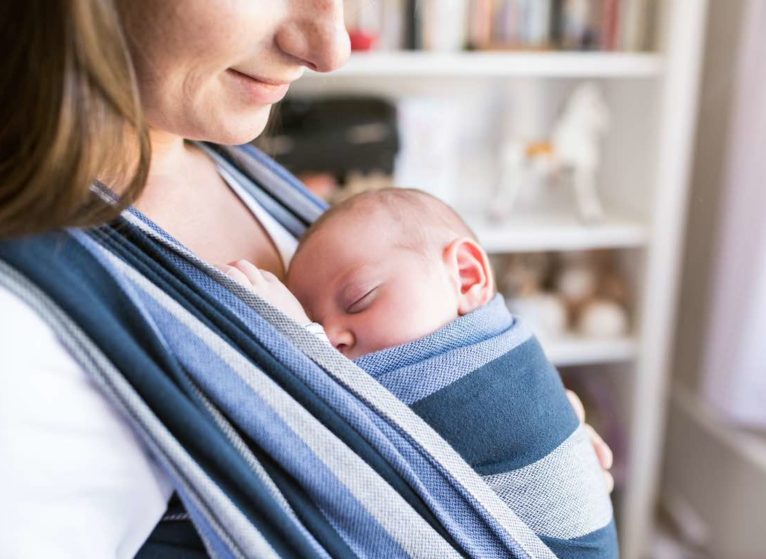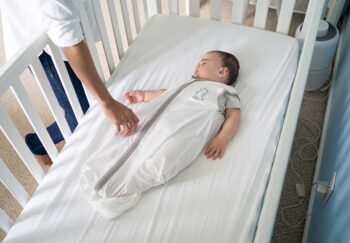When your baby won’t go to sleep or stay asleep, desperation can set in. You’ll try just about anything to catch some Z’s. One night in a swing can’t hurt, right?
We asked Fern Hauck, MD, MS, a UVA Health family medicine doctor and a member of the American Academy of Pediatrics Task Force on Sudden Infant Death Syndrome (SIDS) to weigh in. She shares the latest safe sleep recommendations, which bedtime habits are OK in a pinch, and which ones experts agree simply aren’t safe for your baby.
New Safe-Sleep Guidelines
For the first time in 6 years, the American Academy of Pediatrics (AAP) recently updated its safe-sleep guidelines for infants. The key recommendations remained the same.
- Babies should sleep on their back on a firm, flat surface that's free of soft goods, like blankets and toys.
- Parents should sleep in the same room as baby, but not in the same bed.
However, there are some new additions to the guidelines this year. Hauck and UVA Health Children’s pediatrician Rachel Moon, MD, helped refresh the recommendations based on current research and new products being marketed to improve infant sleep, such as inclined sleepers and weighted blankets.
For the first time, the guidelines also address the fact that sticking to these recommendations 100% of the time can be a challenge.
“All of us writing the guidelines are also parents. We understand there’s desperation at times to get sleep. Often parents know what they are supposed to do, but don’t always do it for various reasons,” says Hauck. “In these guidelines, we expanded on the importance of having an open dialogue about how parents are putting their babies to sleep. We want them to be able to talk to their doctors without judgement so the doctor can make recommendations that may be safer for the baby.”
What to Try & What to Avoid When Your Baby Won’t Go to Sleep
It’s tempting to stray from the rules when your baby won’t go to sleep. But before you opt for one of the strategies below, be sure you know the risks so you can keep your baby safe.
Swings & Bouncy Seats
For some babies, a swing, a bounce, or a bit of vibration may be the ticket to sleepy town.
The Problem: There is an increased risk of suffocation when a baby is sleeping upright because of the positioning of the head.
“A baby’s head is very heavy in relation to the rest of their body,” says Hauck. “Their neck and head control aren’t great, so there’s a chance the head will fall forward or to the side and restrict their airway.” Plus, if left unattended, squirmy babies may tip over or fall out of the seat.
The Verdict: Swings and bouncy seats are suitable to help the baby fall asleep if parents keep a close watch at all times and then move the baby to a flat, safe sleep surface.
Car Seats
Most parents would agree that a baby falling asleep in the car is a blessing. But sleeping upright in a car seat can be risky for babies, especially infants under 4 months old.
The Problem: Just like sitting in a swing or bouncy seat, babies in a car seat have less head control and could suffocate if their head falls forward while asleep. There’s also a chance of strangulation on car seat straps if your baby dozes off and isn’t secured properly.
The Verdict: According to Hauck, there’s no need to keep babies awake on the road. However, she recommends looking back frequently to check on your baby. “When you get to your destination, take the baby out of the car seat and put them on a flat sleep surface,” she says. Also, be sure they’re strapped in correctly, and never use soft pillows or blankets in the car seat to prop up your baby’s head.
Stomach Sleeping
There’s no denying that many babies sleep better on their tummies. But no matter how much your grandma insists, listen to the experts: back is best.
The Problem: Stomach sleeping is one of the biggest risk factors for SIDS. Some researchers believe this is because babies’ airways get restricted or they’re unable to get fresh air.
The Verdict: Parents should never allow the baby to sleep on their stomach. If the baby is old enough to roll over, there’s no need to stand watch and return them to their back. But putting them down to sleep on their back is always best. “If your baby will not go to sleep on their back, you can try a pacifier or, if they’re not rolling over, you can try swaddling to soothe them,” says Hauck. Products to avoid: weighted blankets or any device claiming to keep a baby on their back.
Incline
Although you may have heard that propping a baby up on an incline can prevent SIDS, pneumonia, or acid reflux, there’s no evidence to support it.
The Problem: There have been nearly 200 infant deaths due to inclined sleepers in the U.S. The government recalled many of these products and restricted the sale of inclined devices over 10 degrees because they increase the risk of airway obstruction. Babies can also slide off the device and suffocate.
The Verdict: Parents should avoid using inclined devices or pillows during sleep. “Some parents think that placing the baby at an incline can reduce acid reflux, but that is not true and it is not recommended,” says Hauck.
Baby Carrier or Sling
Keeping your baby close to your chest can be soothing for them. It can also be convenient for you if you can tote them around hands-free. Hooray for multitasking!
The Problem: None. “There’s no harm in allowing your baby to sleep in a carrier or sling as long as their head is turned to the side and there’s plenty of airflow,” says Hauck. “Be sure you can see your baby’s face at all times.”
The Verdict: Carriers and slings can be a great nap time solution. “This is a good way to calm babies and keep a good eye on them,” says Hauck. “It can also help reduce flattening of the head that can happen when babies are always on their backs.”
Co-Sleeping
Co-sleeping or bed-sharing is one of the more complicated topics when it comes to infant sleep. It’s common for parents to bring their baby into their bed during feedings, especially if the baby is nursing. There are also some cultural considerations for families who believe bed-sharing is best.
The Problem: A majority of SIDS deaths happen when babies sleep in the same bed, on a couch, or in a chair with an adult. If that adult smokes or drinks, the risk is even higher. Babies can become lodged between the adult and furniture, entangled in blankets, or covered by pillows — all of these can cause suffocation.
The Verdict: Our doctors don't recommend bed-sharing. But if everything else has failed, you can prepare the space so that it’s as safe as possible.
- Remove any objects around the baby that can lead to suffocation, such as pillows, blankets, or comforters.
- Do not co-sleep if you've been smoking or are under the influence.
- If mom falls asleep during feedings, then as soon as she wakes up, she should move the baby to a separate sleep space.
As an alternative, side sleepers offer the same benefits without the dangers. “Putting a separate sleep surface next to the parents’ bed makes it easier to bring the baby into the parental bed for comforting, and then return them to a safe space after,” says Hauck. “When the baby is 6 months and can roll over and is more vocal, it’s fine to move them to a separate room,” says Hauck.
Having a Baby?
Charlottesville's only Baby-Friendly hospital, UVA Health offers the support you need before, during, and after birth.
When Should Babies Sleep Through the Night?
If you’re eager for your baby to sleep through the night, you’re not alone. But it’s important to have realistic expectations. Most babies do not sleep 8 hours at night without waking until they are 5 to 6 months old, according to Hauck. For smaller babies, this milestone may take longer to reach.
“Having an infant wake up often to feed during the night is actually protective,” says Hauck. “One to 4 months is the peak age for SIDS, so we don’t want babies to sleep for long periods, especially during that first month of life.”
The bottom line for weary parents: Be patient. Be flexible. Be safe. And talk to your baby’s doctor if you have any questions about their sleep routine.


